Processing of Agricultural Products and Food
Straw Feed Processing Project of Baicheng City
1 Project Background
1.1 Project background
1.1.1 Product introduction
Straw feed mainly refers to fiber feed made by crushing and processing straw such as sweet sorghum, corn, reed, cotton, etc. It is the main feed for ruminants.
Straw feed has a sugar content of 15% and belongs to the category of coarse fiber, warm food. After processing, it is very suitable for large livestock such as cattle, horses, and sheep to consume. This project relies on the strong agricultural industry advantages and abundant straw resources of Zhenlai County to build processing workshops and produce straw feed, which is conducive to the resource utilization and commercialization of straw and solves the problems of straw incineration and environmental pollution.
1.1.2 Market prospect
(1) Comprehensive utilization of straw in China
Straw is the largest by-product of China’s grain crops. Straw is the general term for the stems, leaves, and ears of mature crops. It usually refers to the remaining portion of wheat, rice, corn, potatoes, rapeseed, cotton, sugarcane, and other crops (usually coarse grains) after harvesting the seeds.
Straw, as an important biomass resource after crop harvest, has shown a rapid growth trend in yield in the rapid development of agriculture in China. According to statistics from the Food and Agriculture Organization of the United Nations, China’s straw output ranks first in the world, accounting for nearly one-fifth of the global total. The effective utilization of this resource is of great significance for the sustainable development of agriculture and ecological environment protection in China.
The theoretical and collectable resources of crop straw in China rank first in the world each year, accounting for a significant proportion of the total global straw production. Among them, the total amount of straw produced by major crops such as rice, wheat, and corn accounts for a large proportion, and the sum of the three reaches about 80%. The yield distribution of these straw resources varies depending on regional differences and has a direct correlation with grain production.
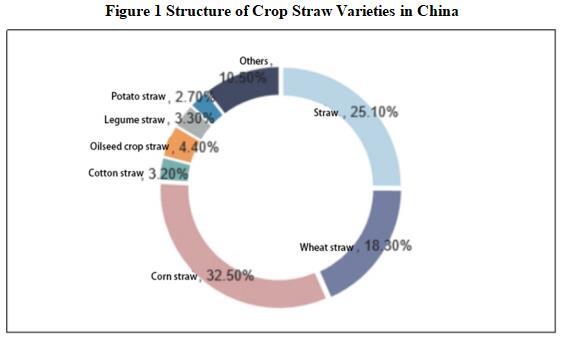
In terms of straw production, the regions from the highest to the lowest are North China, Northeast China, the middle and lower reaches of the Yangtze River, Southwest China, Northwest China, and South China, accounting for 27.18%, 24.47%, 24.35%, 9.19%, 8.87%, and 5.94% of the total straw production in China, respectively.
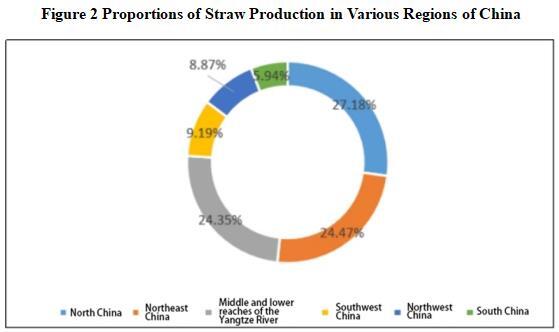
Straw, as a renewable resource, has been fully utilized in various forms worldwide. In developed countries, through technological progress and innovation, straw is not only crushed and returned to the field as organic fertilizer, but also developed into straw feed, straw power generation, straw building materials, etc., forming a circular economy circle that connects industry and agriculture. As a major agricultural country, China has a huge amount of theoretical and collectible straw resources, providing a solid foundation for the comprehensive utilization of straw.
In 2022, China’s theoretical straw resources reached 977 million tons, and the actual collectable resources were about 737 million tons. In 2023, the national straw resources exceeded 2 billion tons.
As a major agricultural producer, China generates a large amount of agricultural waste every year, and there is a great demand for the treatment of agricultural waste. Currently, China has successively issued multiple plans and guidance opinions to promote the efficient utilization of agricultural waste resources, and further increased policy and financial support. The comprehensive utilization rate of agricultural waste has become one of the main indicators for the construction of the evaluation index system for rural revitalization in China. According to data from the Ministry of Agriculture and Rural Affairs, the comprehensive utilization rate of straw in China has exceeded 88%. The utilization rates of straw for fertilizer, feed, energy, base material, and raw material are 57.6%, 20.7%, 8.3%, 0.7%, and 0.8%, respectively. The utilization pattern of “agriculture as the main focus and simultaneous modernization of five aspects” has been formed.
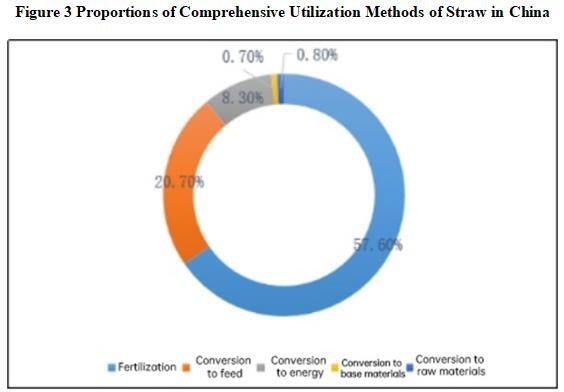
The overall scale of China’s straw industry has steadily grown, and both the supply and demand sides of the industry have maintained a good trend. The increase in value has also contributed to the expansion of the straw industry, and is expected to drive the continuous growth of the straw industry in the future.
(2) The situation of China’s industrial feed market
With the continuous development of China’s animal husbandry industry in recent years, the expansion of breeding scale, and the increasing popularity of pet breeding, the demand for feed in China has been constantly increasing, promoting the development of China’s industrial feed industry. According to the data from the National Bureau of Statistics, in 2023, the number of live pigs in China was 434 million, the number of cattle was 105 million, the number of sheep was 322 million, and the number of poultry was 3.78 billion.
China is the world’s largest producer and consumer of industrial feed. With the continuous development of animal husbandry, the market size of industrial feed is constantly expanding. Thanks to the modernization of agriculture and the rapid development of animal husbandry, the industrial feed industry has maintained a stable growth rate. According to the statistics from China Feed Industry Association, from 2018 to 2023, China’s total feed production increased from 237.63 million tons to 321.627 million tons, with a compound annual growth rate of 6.45%.
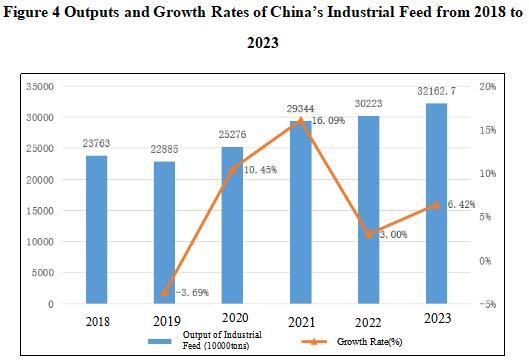
In 2023, the total output of industrial feed in China was 321.627 million tons, an increase of 6.42% over the previous year. In terms of varieties, the output of pig feed increased the most, reaching 149.752 million tons, an increase of 10.1%; the output of egg and poultry feed was 32.744 million tons, an increase of 2.0%; the output of meat and poultry feed was 95.108 million tons, an increase of 6.6%; the feed output of ruminants was 16.715 million tons, an increase of 3.4%; the production of aquatic feed was 23.444 million tons, a decrease of 4.9%; the output of pet feed was 1.463 million tons, an increase of 18.2%; the output of other feed reached 2.402 million tons, an increase of 7.6%.
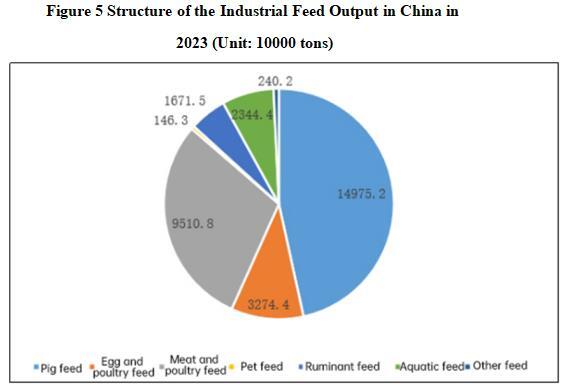
(3) Market situation of ruminant feed in China
According to data from China Feed Industry Association, the output of ruminant feed in China has shown a step by step growth since 2016, exceeding 10 million tons in 2018. In 2022, China’s ruminant animal feed production was 16.168 million tons, an increase of 9.22%. In 2023, China’s ruminant animal feed production was 16.715 million tons, an increase of 3.38%. However, due to the influence of China’s aquaculture structure, the research and output of ruminant animal feed have a relatively small market share in China’s feed industry. Although the market share has increased in recent years, the overall market share is only about 5%. Therefore, it is expected that with the continuous development of China’s animal husbandry industry in the future, the industry will also usher in greater development space.

At present, the demand for ruminant feed in China mainly comes from the livestock industry. In recent years, with the stable growth of the economy, the increase in residents’ income, and the transformation of food consumption structure, the demand for high-quality animal protein such as beef, mutton, and dairy has been continuously increasing, which has driven the development of animal husbandry. Relevant data shows that at present, the per capita consumption of beef in China is 7.31kg/year, and the consumption of beef accounts for 9.92%; the per capita consumption of mutton is 4.08 kilograms per year, with the mutton consumption accounting for 5.54%.
With the growth of domestic consumption of beef, mutton, and dairy products, the scale of ruminant animal breeding in China is increasing, driving the continuous growth of demand for ruminant animal feed market. However, the domestic industrial feed production is far lower than the standardized breeding demand, and the market space for ruminant feed is very broad.
(4) China’s straw feed market
As a major producer of grain crops, China has abundant straw resources, which contain a large amount of usable nutrients such as fiber and crude protein. Straw is a good coarse feed resource for herbivorous animals such as cattle and sheep. For example, corn stover has a neutral detergent fiber content of 69.1% -82.5%, an acidic detergent fiber content of 37.2% -47.1%, a crude protein content of 4.9% -8.7%, and a crude fat content of 1.4% -1.7%. They are all essential “grains and cereals” for cattle and sheep. If scientifically processed to improve their nutritional quality, they may even replace high-quality forage as the “main food” for herbivorous animals.
Straw feed has become the main source of feed for ruminant animals such as cattle and sheep due to its low cost and rich nutrition. With the large-scale and intensive development of animal husbandry, the demand for feed continues to increase, and straw feed is widely welcomed due to its advantages such as low cost and rich nutrition. Especially in northern regions, corn stover has played an important supporting role in the development of animal husbandry. With the advancement of technology and changes in market demand, the application prospects of straw feed in aquaculture are becoming increasingly broad. In 2022, the market size of straw feed in China was 41.536 billion yuan, a year-on-year increase of 4.12%.
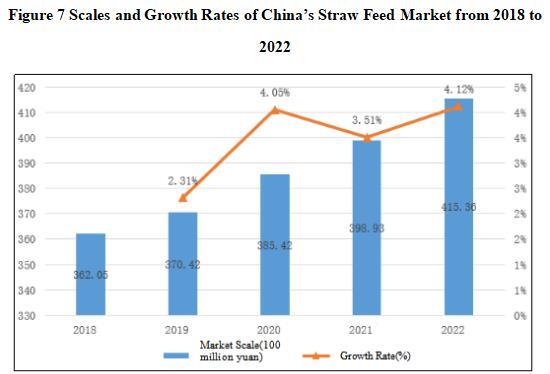
With the rapid development of animal husbandry and the increasing scarcity of feed resources, the market demand for straw feed will continue to grow. Especially with the deepening implementation of environmental protection policies and the advancement of agricultural modernization, the comprehensive utilization of straw feed will be further promoted and applied. The project relies on the abundant straw resources in Zhenlai County to build a straw feed processing base, undertake the development of straw feed processing, promote agricultural structural adjustment and development mode transformation, enhance industrial management level, and have broad market prospects.
1.1.3 Technical analysis
The production technology of crop straw processed feed mainly includes straw ammonification technology, straw feed compaction technology, straw grass powder production technology, straw kneading processing technology, protein production technology from agricultural and forestry waste, enzymatic hydrolysis technology, deep treatment technology, microbial fermentation technology, etc.
The project mainly adopts some technologies such as “protein production from agricultural and forestry waste” and “enzymatic hydrolysis technology” to produce ruminant feed. This technology is mature and widely used in the market, and can provide technical support for project construction.
(1) Protein production technology from agricultural and forestry waste
Mainly utilizing the biological activities of cellulose degrading enzymes and starch degrading enzymes, as well as in vitro multi enzyme molecular systems, and the biotransformation after fermentation with brewing yeast, it is possible to efficiently hydrolyze cellulose in corn stover to synthesize artificial starch, while producing microbial protein through low-cost fermentation under aerobic conditions.
(2) Enzymatic hydrolysis technology
The enzymatic hydrolysis technology is used to process crop straw, converting cellulose and hemicellulose into easily consumable sugars, thereby improving the nutritional value of feed.
1.1.4 Advantageous conditions of project construction
(1) Policy advantages
The Guiding Opinions on the Comprehensive Utilization of Bulk Solid Waste in the 14th Five-Year Plan proposes to vigorously promote the comprehensive utilization of straw and improve the quality and efficiency of the straw comprehensive utilization industry. Adhere to prioritizing agricultural use, continuously promote the utilization of straw as fertilizer, feed, and base material, and give full play to the functions of straw farmland conservation and the combination of planting and breeding.
The Action Plan for Peaking Carbon Emissions Before 2030 proposes to accelerate the high-value utilization of straw, improve the collection, storage, and transportation system, and strictly prohibit burning and control. By 2025, the annual utilization of bulk solid waste will have been around 4 billion tons, and by 2030, it will have reached around 4.5 billion tons. Strengthen the comprehensive utilization of crop straw and the resource utilization of livestock and poultry manure.
The 14th Five-Year Plan for Promoting Agricultural and Rural Modernization of the State Council proposes to comprehensively implement the action of straw comprehensive utilization, improve the straw collection, storage and transportation system, and enhance the energy and feed utilization capacity of straw.
The Implementation Plan for Promoting High-quality Development of New Energy in the New Era proposed by the National Development and Reform Commission and the International Energy Agency aims to deepen the comprehensive utilization of straw and the resource utilization of livestock and poultry manure.
(2) Resource advantages
Zhenlai County covers an area of 4718.69 square kilometers, with a total of 187300 hectares of arable land, 404.19 hectares of garden land, 40300 hectares of forest land, 41100 hectares of grassland, 13800 hectares of urban and industrial land, 9563.47 hectares of transportation land, 95200 hectares of water bodies and water conservancy facilities, and 84200 hectares of other land. Adequate industrial and construction land.
(3) Industrial advantages
As the largest rice planting county and one of the main corn producing areas in Jilin Province, Zhenlai County has an annual output of over 1.2 million tons of straw. Zhenlai County actively promotes the development of straw feed industry, and through a series of technological means, converts straw into feed, effectively ensuring the feed supply of the entire beef cattle breeding industry in the county. As of 2022, the utilization rate of straw feed in Zhenlai County has reached 39%, and the straw feed utilization has reached 400000 tons. In addition, Zhenlai County has formulated relevant policies and measures to promote the comprehensive utilization of straw, including energy, fertilizer, feed and other utilization methods to ensure that straw should be treated and utilized reasonably.
(4) Location advantages
Zhenlai County is located at the junction of the three major resource provinces (regions) of Heilongjiang, Jilin, and Inner Mongolia, and is known as the place “where rooster crowing can be heard in three provinces”. Within a radius of 200 kilometers, it is surrounded by five prefecture level cities (Songyuan, Baicheng, Qiqihar, Daqing, Ulanhot) and five regional airports, and is only 40 kilometers away from Baicheng Airport. There are two railways and two highways intersecting within the territory, making it an important “hub” city at the junction of Heilongjiang Province, Jilin Province, and Inner Mongolia. It is a must pass place for Inner Mongolia and Heilongjiang to enter the country, with convenient transportation and developed logistics, and has strong advantages in radiation and driving.
(5) Talent advantages
There are several research institutes in Baicheng City, including the Academy of Agricultural Sciences, the Academy of Forestry Sciences, the Agricultural Machinery Research Institute, the Livestock Research Institute, and the Research Institute. There are 40873 professional and technical personnel, including 6898 with senior professional titles, 18409 with intermediate professional titles, and 15566 with junior professional titles. Baicheng Academy of Agricultural Sciences is the only comprehensive agricultural research institution in the semi-arid special ecological zone of western Jilin Province. It is the forefront and main research group for agricultural technology innovation and promotion in western Jilin Province.
1.2 Contents and scale of project construction
1.2.1 Product scale
The project reaches its production capacity in the year, with an annual output of 500000 tons of straw feed.
1.2.2 Construction contents of the project
The project covers an area of 100000 square meters and has a building area of 80000 square meters. It mainly constructs the production and processing workshops and other buildings, purchases 20 sets of straw feed production equipment, and builds supporting facilities such as water, electricity, heating, ground hardening, and greening.
1.3 Total investment of the project and capital raising
1.3.1 Total investment of the project
The total investment of the project is 500 million yuan, including the construction investment of 450 million yuan and current funds of 50 million yuan.

1.3.2 Capital raising
Self-financing by the enterprise
1.4 Financial analysis and social evaluation
1.4.1 Main financial indexes
After the project reaches the production capacity, its annual sales revenue will be 500 million yuan, its profit will be 150 million yuan, its investment payback period will be 5.3 years (after the tax, including the construction period of 2 years) and its return on investment will be 30.0%.
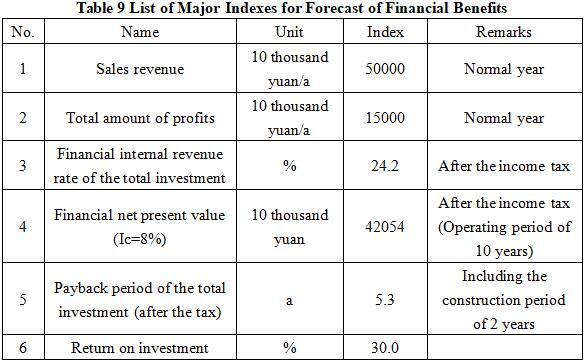
Note: “10 thousand yuan” in the table is in RMB.
1.4.2 Social evaluation
The project’s use of straw to produce and process feed is a major revolution in China’s agricultural production technology. The construction of the project has increased the ways of resource recycling, improved the living environment of rural residents, and is an important measure to promote the green and sustainable development of animal husbandry. It also has a great promoting effect on increasing farmers’ income and employment.
1.5 Cooperative way
Sole proprietorship or joint venture
1.6 What to be invested by the foreign party
Funds, equipment or technology
1.7 Construction site of the project
Zhenlai County, Baicheng City
1.8 Progress of the project
The project proposal has been prepared.
2 Introduction to the Partner
2.1 Basic information
Name: Zhenlai Project Development Service Center
Address: 1777 Xinxing South Street, Zhenlai Town, Zhenlai County, Baicheng City
2.2 Overview
Zhenlai County is located in the northwest of Jilin Province, at the junction of Jilin Province, Heilongjiang Province, and Inner Mongolia, and is a convergence zone of the Songnen Plain and the Horqin Grassland. To the east is the Nenjiang River, facing Duerbote Mongolian Autonomous County and Zhaoyuan County in Heilongjiang Province across the river, to the west is Ulanhot City in Inner Mongolia Autonomous Region, to the north is Tailai County in Heilongjiang Province and Zhalaite Banner in Inner Mongolia Autonomous Region, and to the southwest and south are adjacent to Baicheng City, Da’an City, and Taobei District respectively. Zhenlai County is a large-scale commodity grain base and livestock development demonstration base in China. The location and transportation advantages of Zhenlai County are obvious, with Zhenlai County as the center and a radius of 500 kilometers, which can comprehensively cover industrial cities and resource rich areas in the northeast region.
In 2023, the county’s GDP reached 9.48 billion yuan, a year-on-year increase of 6.6%; the fixed assets investment reached 2 billion yuan, up 23.6% year on year; the total output value of industrial enterprises above the designated size reached 2.7 billion yuan, a year-on-year increase of 9%; the added value of industrial enterprises above the designated size reached 780 million yuan, a year-on-year increase of 7%; the total retail sales of consumer goods reached 1.42 billion yuan, a year-on-year increase of 7%; the local level fiscal revenue reached 400 million yuan, a year-on-year increase of 20%; the per capita disposable income of urban residents increased by 8% year-on-year; the per capita disposable income of rural residents increased by 9% year-on-year.
2.3 Contact method
2.3.1 Contact method
Contact unit: Zhenlai Project Development Service Center
Contact person: Tian Tian
Tel: +86-15886168765
2.3.2 Contact method of the city (prefecture) where the project is located
Contact unit: Baicheng Bureau of Commerce
Contact person: Xu Zengchun
Tel: +86-436-3203010
+86-13894682986
E-mail: bcjhj07@126.com


